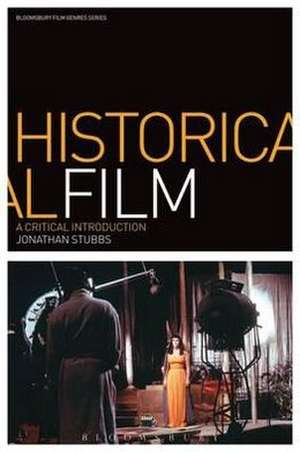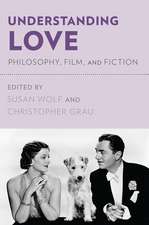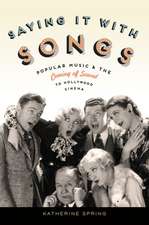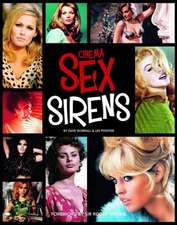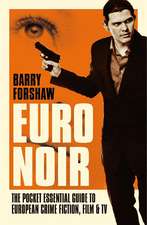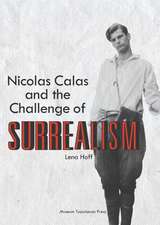Historical Film: A Critical Introduction: Film Genres
Autor Jonathan Stubbsen Limba Engleză Paperback – 22 mai 2013
| Toate formatele și edițiile | Preț | Express |
|---|---|---|
| Paperback (1) | 198.22 lei 6-8 săpt. | |
| Bloomsbury Publishing – 22 mai 2013 | 198.22 lei 6-8 săpt. | |
| Hardback (1) | 772.98 lei 6-8 săpt. | |
| Bloomsbury Publishing – 22 mai 2013 | 772.98 lei 6-8 săpt. |
Preț: 198.22 lei
Preț vechi: 229.87 lei
-14% Nou
Puncte Express: 297
Preț estimativ în valută:
37.95€ • 39.44$ • 31.46£
37.95€ • 39.44$ • 31.46£
Carte tipărită la comandă
Livrare economică 08-22 februarie 25
Preluare comenzi: 021 569.72.76
Specificații
ISBN-13: 9781847884978
ISBN-10: 1847884970
Pagini: 224
Ilustrații: illustrations
Dimensiuni: 156 x 235 x 20 mm
Greutate: 0.36 kg
Editura: Bloomsbury Publishing
Colecția Bloomsbury Academic
Seria Film Genres
Locul publicării:London, United Kingdom
ISBN-10: 1847884970
Pagini: 224
Ilustrații: illustrations
Dimensiuni: 156 x 235 x 20 mm
Greutate: 0.36 kg
Editura: Bloomsbury Publishing
Colecția Bloomsbury Academic
Seria Film Genres
Locul publicării:London, United Kingdom
Caracteristici
Draws
on
a
massive
amount
of
original
research
and
detailed
analyses
of
films
across
the
genre,
from
the
silent
era
through
to
the
present,
highly
digitized
age
Notă biografică
Jonathan
Stubbsis
Associate
Professor
in
the
Communication
Faculty
at
Cyprus
International
University.
Cuprins
List
of
IllustrationsAcknowledgementIntroduction:
Film
and
the
Invention
of
HistoryChapter
One:
What
is
Historical
Cinema?Chapter
Two:
Detail,
Authenticity
and
the
Uses
of
the
PastChapter
Three:
Hollywood
Historical
Cinema
up
to
WWIIChapter
Four:
The
Age
of
EpicsChapter
Five:
New
Hollywood,
New
HistoriesChapter
Six:
Spectacle,
Technology
and
AestheticsChapter
Seven:
Prestige,
Education
and
Cultural
ValueConclusion:
The
Role
of
the
HistorianAnnotated
Guide
to
Further
ReadingBibliographyFilmographyIndex
Recenzii
At
the
intersection
of
film
and
history,
no
topic
has
attracted
as
much
scholarly
attention
in
recent
years
as
the
genre
of
historical
film.
Jonathan
Stubbs'
book
is
not
only
an
authoritative
guide
to
the
on-going
debates
about
this
genre,
but
also
a
major
new
contribution
to
them,
demonstrating
that
historical
films
have
been
at
the
very
heart
of
Hollywood's
operations
for
much
of
the
industry's
history.
The
book
draws
on
an
immense
amount
of
original
research
and
combines
wonderfully
perceptive,
detailed
film
analyses
with
surveys
of
major
developments
and
discussions
of
key
themes.
It
will
be
of
great
interest
both
to
film
scholars
and
to
historians.
A hugely insightful and valuable book, which should be required reading for anyone with an interest in the ways that history has been used as a subject and setting for popular cinema. Stubbs provides an outstanding well researched account of the ways that historical film developed as a genre over the last century, which never loses sight of the ways that movies are shaped by cultural, economic and social factors. What's particularly impressive is that this story is told using almost entirely new research into the production and reception of a hugely diverse range of movies. As a result, the book is easily the most thorough account of Hollywood's historical films ever produced. However, the greatest strength of Stubbs' book is that it combines rigorous research with a truly challenging and convincing exploration of the debates which surround historical film. Too often, historians and scholars become fixated on questions of historical accuracy, and this means that they can assess movies about the past in relatively narrow terms. Stubbs goes far beyond these issues, and instead focuses his attention on how history films provide pleasure through spectacle, as well as how they seek to (or at least claim to) educate viewers. In the final section, he turns his attention to critical debates around historical films and explains how history itself has come to be understood in contemporary culture. This is, then, a book about historical films, but it is also an account of how historians, filmmakers and ordinary viewers have used cinema to make sense of the past, and the present. It is, quite simply, remarkable.
When reflecting on known theories within the field, and in offering his own, Stubbs' writing is well informed and innovative
A hugely insightful and valuable book, which should be required reading for anyone with an interest in the ways that history has been used as a subject and setting for popular cinema. Stubbs provides an outstanding well researched account of the ways that historical film developed as a genre over the last century, which never loses sight of the ways that movies are shaped by cultural, economic and social factors. What's particularly impressive is that this story is told using almost entirely new research into the production and reception of a hugely diverse range of movies. As a result, the book is easily the most thorough account of Hollywood's historical films ever produced. However, the greatest strength of Stubbs' book is that it combines rigorous research with a truly challenging and convincing exploration of the debates which surround historical film. Too often, historians and scholars become fixated on questions of historical accuracy, and this means that they can assess movies about the past in relatively narrow terms. Stubbs goes far beyond these issues, and instead focuses his attention on how history films provide pleasure through spectacle, as well as how they seek to (or at least claim to) educate viewers. In the final section, he turns his attention to critical debates around historical films and explains how history itself has come to be understood in contemporary culture. This is, then, a book about historical films, but it is also an account of how historians, filmmakers and ordinary viewers have used cinema to make sense of the past, and the present. It is, quite simply, remarkable.
When reflecting on known theories within the field, and in offering his own, Stubbs' writing is well informed and innovative
